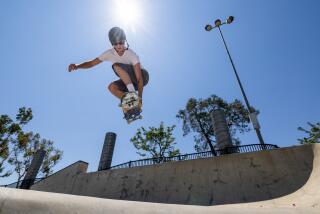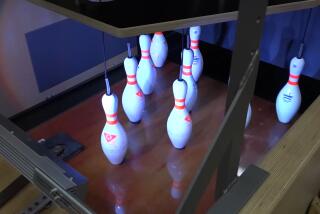The Physics Behind Sports, Fun and Games
- Share via
What does physics have to do with baseball, football and roller coasters? Everything! How a baseball curves, how a football spirals and how a roller-coaster car stays on the track can all be explained through the laws of physics. Learn how physics determines the design of sports equipment and amusement rides and how following its laws can improve athletes’ performance, through the direct links on the Times Launch Point Web site, https://www.latimes.com/launchpoint/
Level 1
Bill Nye’s Science of Sports: Like a rocket or a bird, a football’s unique shape helps determine how it sails through the air; throwing it with a spiral helps the football stay on a straight path. Whether you’re interested in tennis, baseball or ice skating, learn how scientific principles make the difference in the sports you play.
https://espn.go.com/editors/nye/june97.html
Seesaw Physics: When you ride a seesaw, you are using a lever, a device that can be used to either weigh objects or to make moving heavy objects easier. Explore how levers work through some seesaw experiments.
https://lyra.colorado.edu/sbo/mary/play/lever.html
Swing Set Physics: Become a swing set scientist as you study how swings work just like a pendulum. Discover for yourself what makes a swing swing best.
https://lyra.colorado.edu/sbo/mary/play/pendulum.html
Level 2
Sports Science Meets the Olympics: Learn how scientists use computers and the principles of biomechanics to help Olympic high jumpers improve their leaps. See animation that shows how a change in position can increase body rotation and thus increase the height of the jump.
https://whyfiles.news.wisc.edu/019olympic/index.html
History of Golf Ball Aerodynamics: Why do golf balls have dimples? Travel back in time and see how the design of the golf ball has changed over the ages. View animation that shows how lift and drag affect the movement of the ball in the air, and why those dimples increase a golf ball’s velocity.
https://www.titleist.com/balls/tech2.htm
Tennis Sport Science: Learn about the aerodynamics of tennis--how air moves and how such factors as pressure, density and friction affect the movement of the ball. View computer simulations and learn about research conducted at the 1997 U.S. Open with radar guns, wind tunnels, computers and video equipment.
https://wings.ucdavis.edu/Tennis/index.html
Level 3
Sport! Science: How are the principles of momentum, gravity, friction and centripetal force important to skateboarding? Explore the fun of physics through interactive exhibits on skateboarding, baseball, hockey and cycling.
https://www.exploratorium.edu/sports/index.html
Sports Aerodynamics: Do the seams of a baseball influence its flight? View simulations of pitches and see how changing factors like rotational speed and velocity can affect a pitch. Study golf ball trajectories and see how spin can help an object stay on course.
https://www.simscience.org/fluid/blue/sports.html
Amusement Park Physics: Roller-coaster designers rely upon the laws of physics to create thrilling, but safe, rides. Discover how rides are designed and try your hand at creating one of your own online, which will be judged for its fun and for its safety.
https://www.learner.org/exhibits/parkphysics/
EXPLORER’S QUEST
The answer to this Internet quiz can be found in the sites at right.
What principle explains the force that keeps tennis balls and airplanes in the air?
CLUE: See Bill Nye’s Science of Sports
Find What You Need to Know: Have a project on California history? Need help doing a math problem? Launch Point now covers more than 100 topics for getting your schoolwork done. Go to https://www.latimes.com/launchpoint/ for the full list of subjects and direct links to the best Internet sites.
Answer to last week’s Quest: Galileo discovered the rings around Saturn and the moons of Jupiter.
Launch Point is produced by the UC Irvine department of education, which reviews each site for appropriateness and quality. Even so, parents should supervise their children’s use of the Internet. This column was designed by Anna Manring.
More to Read
Go beyond the scoreboard
Get the latest on L.A.'s teams in the daily Sports Report newsletter.
You may occasionally receive promotional content from the Los Angeles Times.






